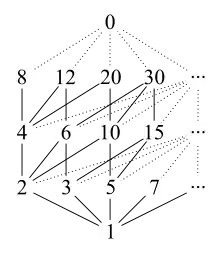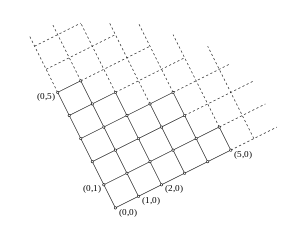Well-quasi-ordering
In mathematics, specifically order theory, a well-quasi-ordering or wqo is a quasi-ordering such that any infinite sequence of elements from contains an increasing pair with .
Motivation
Well-founded induction can be used on any set with a well-founded relation, thus one is interested in when a quasi-order is well-founded. (Here, by abuse of terminology, a quasiorder is said to be well-founded if the corresponding strict order is a well-founded relation.) However the class of well-founded quasiorders is not closed under certain operations—that is, when a quasi-order is used to obtain a new quasi-order on a set of structures derived from our original set, this quasiorder is found to be not well-founded. By placing stronger restrictions on the original well-founded quasiordering one can hope to ensure that our derived quasiorderings are still well-founded.
An example of this is the power set operation. Given a quasiordering for a set one can define a quasiorder on 's power set by setting if and only if for each element of one can find some element of that is larger than it with respect to . One can show that this quasiordering on needn't be well-founded, but if one takes the original quasi-ordering to be a well-quasi-ordering, then it is.
Formal definition
A well-quasi-ordering on a set is a quasi-ordering (i.e., a reflexive, transitive binary relation) such that any infinite sequence of elements from contains an increasing pair with . The set is said to be well-quasi-ordered, or shortly wqo.
A well partial order, or a wpo, is a wqo that is a proper ordering relation, i.e., it is antisymmetric.
Among other ways of defining wqo's, one is to say that they are quasi-orderings which do not contain infinite strictly decreasing sequences (of the form ) nor infinite sequences of pairwise incomparable elements. Hence a quasi-order (X, ≤) is wqo if and only if (X, <) is well-founded and has no infinite antichains.
Examples


- , the set of natural numbers with standard ordering, is a well partial order (in fact, a well-order). However, , the set of positive and negative integers, is not a well-quasi-order, because it is not well-founded (see Pic.1).
- , the set of natural numbers ordered by divisibility, is not a well-quasi-order: the prime numbers are an infinite antichain (see Pic.2).
- , the set of vectors of natural numbers (where is finite) with component-wise ordering, is a well partial order (Dickson's lemma; see Pic.3). More generally, if is well-quasi-order, then is also a well-quasi-order for all .
- Let be an arbitrary finite set with at least two elements. The set of words over ordered lexicographically (as in a dictionary) is not a well-quasi-order because it contains the infinite decreasing sequence . Similarly, ordered by the prefix relation is not a well-quasi-order, because the previous sequence is an infinite antichain of this partial order. However, ordered by the subsequence relation is a well partial order.[1] (If has only one element, these three partial orders are identical.)
- More generally, , the set of finite -sequences ordered by embedding is a well-quasi-order if and only if is a well-quasi-order (Higman's lemma). Recall that one embeds a sequence into a sequence by finding a subsequence of that has the same length as and that dominates it term by term. When is an unordered set, if and only if is a subsequence of .
- , the set of infinite sequences over a well-quasi-order , ordered by embedding, is not a well-quasi-order in general. That is, Higman's lemma does not carry over to infinite sequences. Better-quasi-orderings have been introduced to generalize Higman's lemma to sequences of arbitrary lengths.
- Embedding between finite trees with nodes labeled by elements of a wqo is a wqo (Kruskal's tree theorem).
- Embedding between infinite trees with nodes labeled by elements of a wqo is a wqo (Nash-Williams' theorem).
- Embedding between countable scattered linear order types is a well-quasi-order (Laver's theorem).
- Embedding between countable boolean algebras is a well-quasi-order. This follows from Laver's theorem and a theorem of Ketonen.
- Finite graphs ordered by a notion of embedding called "graph minor" is a well-quasi-order (Robertson–Seymour theorem).
- Graphs of finite tree-depth ordered by the induced subgraph relation form a well-quasi-order,[2] as do the cographs ordered by induced subgraphs.[3]
Wqo's versus well partial orders
In practice, the wqo's one manipulates are quite often not orderings (see examples above), and the theory is technically smoother if we do not require antisymmetry, so it is built with wqo's as the basic notion. On the other hand, according to Milner 1985, no real gain in generality is obtained by considering quasi-orders rather than partial orders... it is simply more convenient to do so.
Observe that a wpo is a wqo, and that a wqo gives rise to a wpo between equivalence classes induced by the kernel of the wqo. For example, if we order by divisibility, we end up with if and only if , so that .
Infinite increasing subsequences
If is wqo then every infinite sequence contains an infinite increasing subsequence (with ). Such a subsequence is sometimes called perfect. This can be proved by a Ramsey argument: given some sequence , consider the set of indexes such that has no larger or equal to its right, i.e., with . If is infinite, then the -extracted subsequence contradicts the assumption that is wqo. So is finite, and any with larger than any index in can be used as the starting point of an infinite increasing subsequence.
The existence of such infinite increasing subsequences is sometimes taken as a definition for well-quasi-ordering, leading to an equivalent notion.
Properties of wqos
- Given a quasiordering the quasiordering defined by is well-founded if and only if is a wqo.[4]
- A quasiordering is a wqo if and only if the corresponding partial order (obtained by quotienting by ) has no infinite descending sequences or antichains. (This can be proved using a Ramsey argument as above.)
- Given a well-quasi-ordering , any sequence of upward-closed subsets eventually stabilises (meaning there exists such that ; a subset is called upward-closed if ): assuming the contrary , a contradiction is reached by extracting an infinite non-ascending subsequence.
- Given a well-quasi-ordering , any subset of has a finite number of minimal elements with respect to , for otherwise the minimal elements of would constitute an infinite antichain.
Notes
^ Here x < y means: and
- Gasarch, W. (1998), "A survey of recursive combinatorics", Handbook of Recursive Mathematics, Vol. 2, Stud. Logic Found. Math., 139, Amsterdam: North-Holland, pp. 1041–1176, doi:10.1016/S0049-237X(98)80049-9, MR 1673598. See in particular page 1160.
- Nešetřil, Jaroslav; Ossona de Mendez, Patrice (2012), "Lemma 6.13", Sparsity: Graphs, Structures, and Algorithms, Algorithms and Combinatorics, 28, Heidelberg: Springer, p. 137, doi:10.1007/978-3-642-27875-4, ISBN 978-3-642-27874-7, MR 2920058.
- Damaschke, Peter (1990), "Induced subgraphs and well-quasi-ordering", Journal of Graph Theory, 14 (4): 427–435, doi:10.1002/jgt.3190140406, MR 1067237.
- Forster, Thomas (2003). "Better-quasi-orderings and coinduction". Theoretical Computer Science. 309 (1–3): 111–123. doi:10.1016/S0304-3975(03)00131-2.
References
- Dickson, L. E. (1913). "Finiteness of the odd perfect and primitive abundant numbers with r distinct prime factors". American Journal of Mathematics. 35 (4): 413–422. doi:10.2307/2370405. JSTOR 2370405.
- Higman, G. (1952). "Ordering by divisibility in abstract algebras". Proceedings of the London Mathematical Society. 2: 326–336. doi:10.1112/plms/s3-2.1.326.
- Kruskal, J. B. (1972). "The theory of well-quasi-ordering: A frequently discovered concept". Journal of Combinatorial Theory. Series A. 13 (3): 297–305. doi:10.1016/0097-3165(72)90063-5.
- Ketonen, Jussi (1978). "The structure of countable Boolean algebras". Annals of Mathematics. 108 (1): 41–89. doi:10.2307/1970929. JSTOR 1970929.
- Milner, E. C. (1985). "Basic WQO- and BQO-theory". In Rival, I. (ed.). Graphs and Order. The Role of Graphs in the Theory of Ordered Sets and Its Applications. D. Reidel Publishing Co. pp. 487–502. ISBN 90-277-1943-8.
- Gallier, Jean H. (1991). "What's so special about Kruskal's theorem and the ordinal Γo? A survey of some results in proof theory". Annals of Pure and Applied Logic. 53 (3): 199–260. doi:10.1016/0168-0072(91)90022-E.